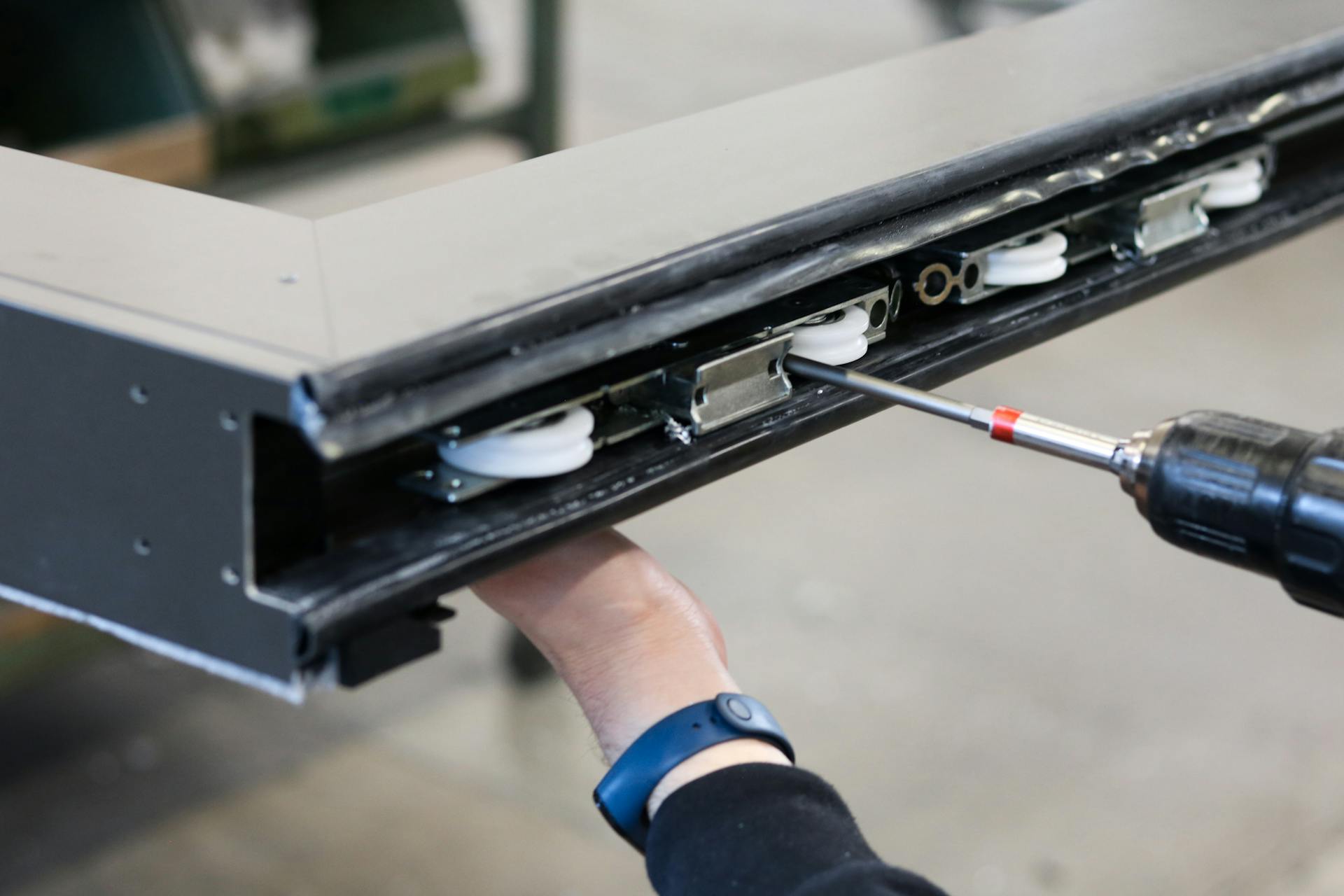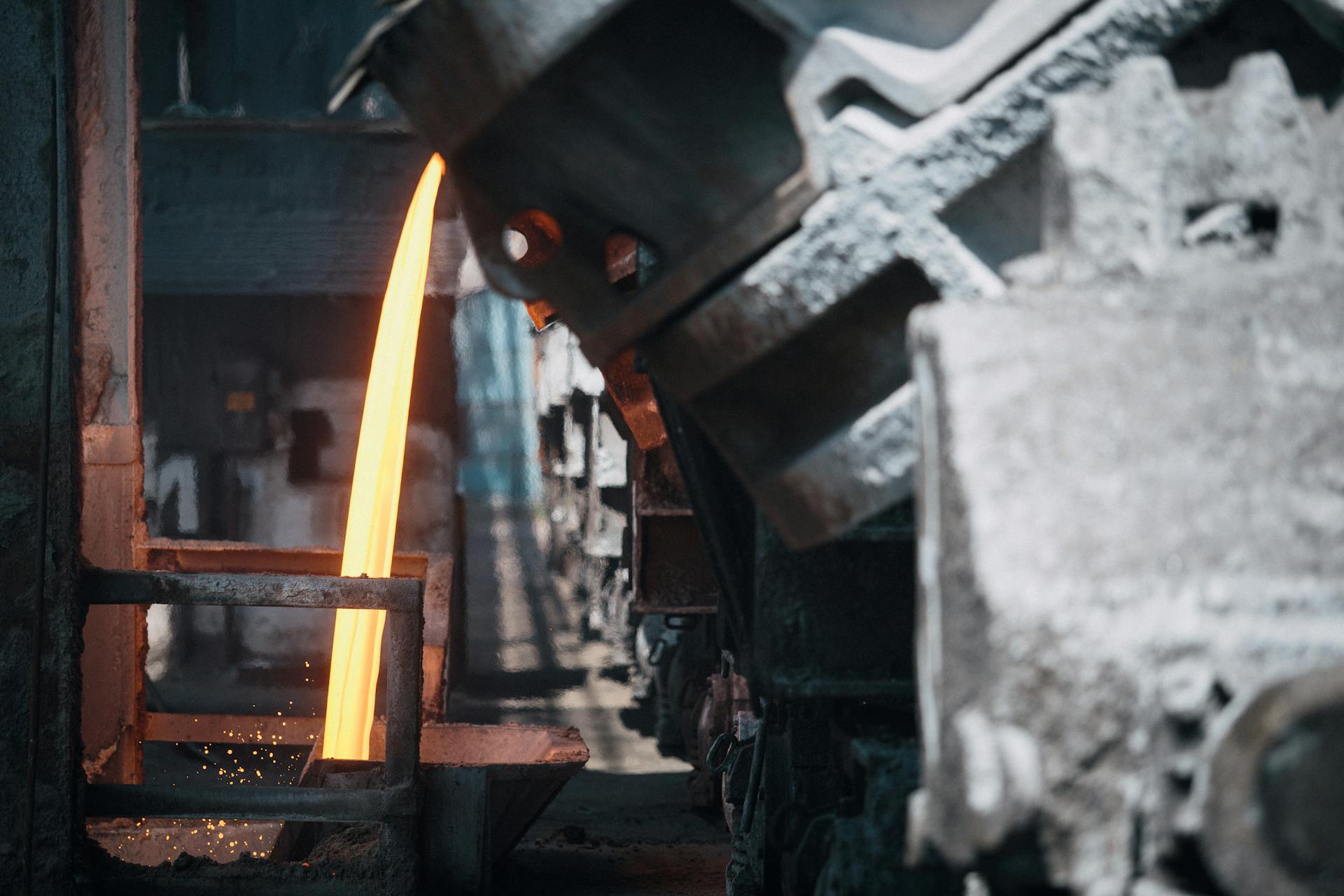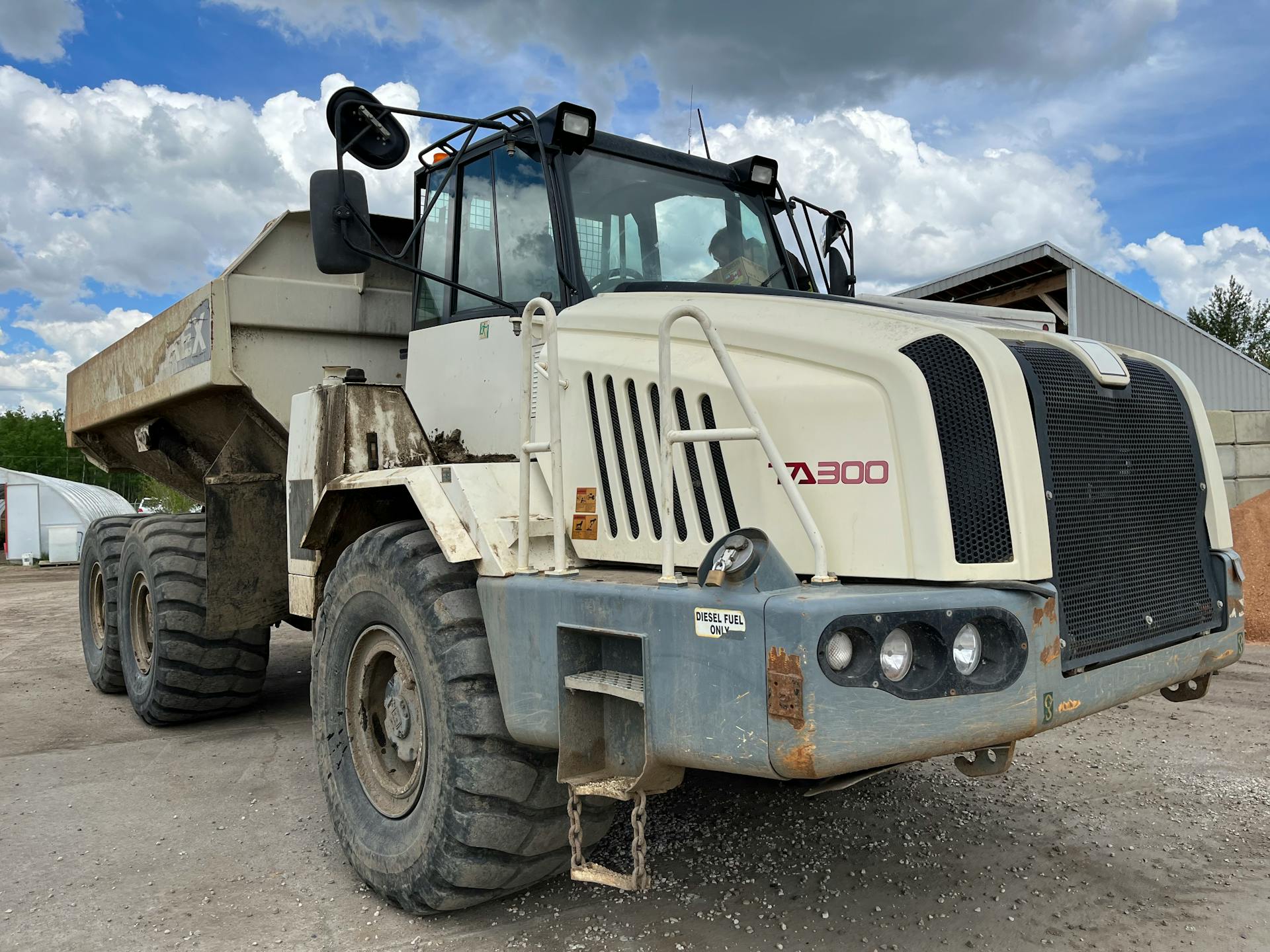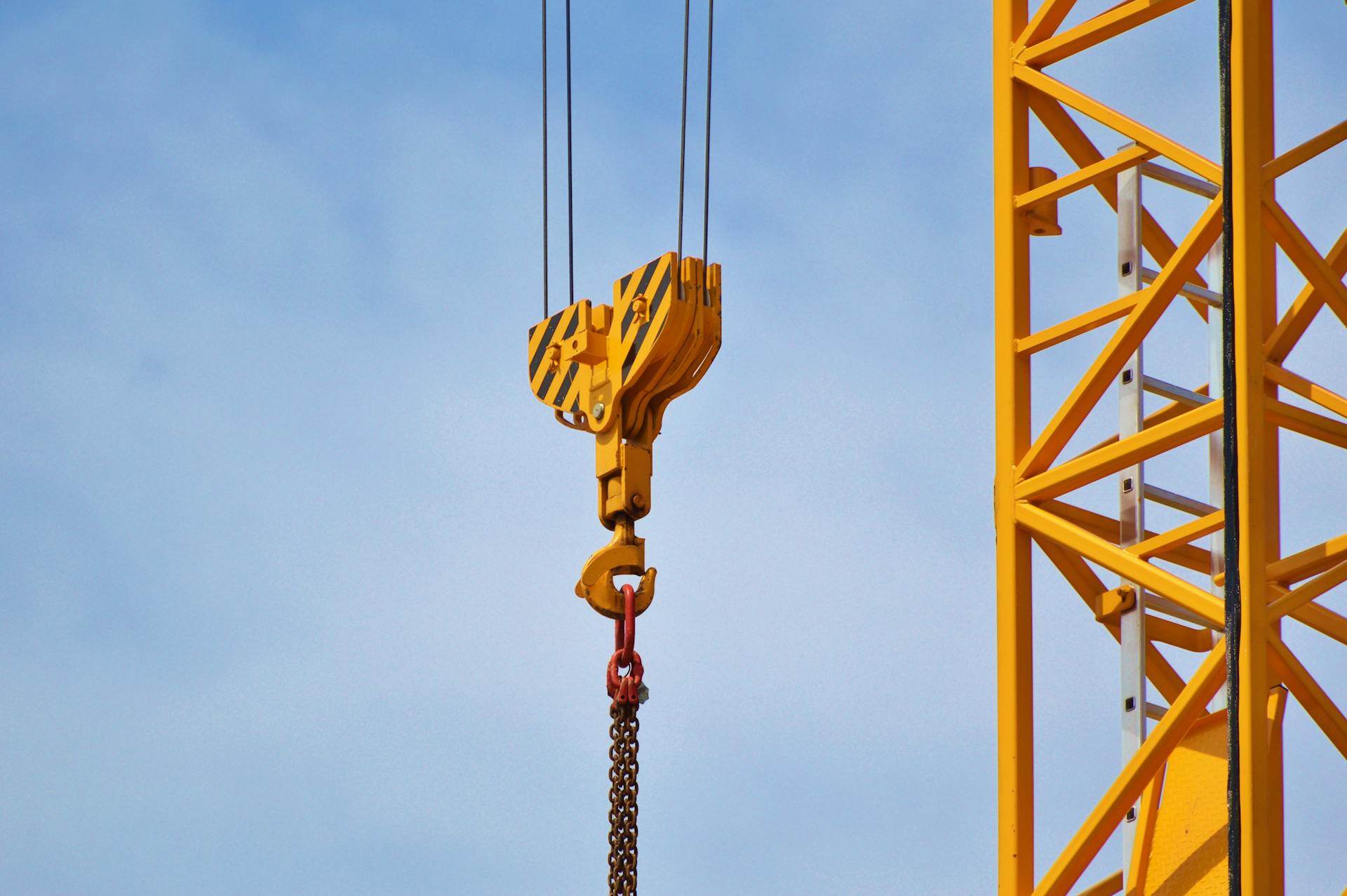
Heavy manufacturing involves the production of large, complex products such as aircraft and ships, which requires significant investment in equipment and infrastructure.
These products often have a long lifespan and can be repaired or upgraded over time, making them more sustainable in the long run.
In contrast, light manufacturing typically involves the production of smaller, less complex items such as textiles and electronics.
Light manufacturing often relies on automated systems and lean production methods to minimize waste and maximize efficiency.
Heavy manufacturing, on the other hand, often requires a large workforce to operate and maintain the equipment and facilities involved in the production process.
A different take: Light Manufacturing Zoning
Differences Between Heavy and Light Manufacturing
Heavy manufacturing is often associated with large-scale production of goods, and it's no surprise why. It's typically established far from cities to be closer to the source of natural resources and due to the high pollution it generates.
One key characteristic of heavy manufacturing is its high consumption of resources like electricity and water. This is because the production system requires a lot of energy and inputs to operate.
Heavy industries also tend to have a significant impact on the environment, with a high level of waste and pollution generated as a byproduct of their operations. This is due in part to the extraction and processing of natural resources.
In contrast, light manufacturing tends to be more environmentally friendly, with a lower level of waste and impact on the environment. This is because the production system requires less consumption of resources.
Here's a quick comparison of the two:
Examples of heavy industries include industries that extract and process natural resources, such as mining and oil refining.
Advantages and Disadvantages
Heavy manufacturing offers several advantages, including lower costs per unit due to economies of scale. This is because heavy manufacturing involves producing large quantities of products, allowing companies to negotiate better prices with suppliers and reduce waste.
One significant disadvantage of heavy manufacturing is its high initial investment requirement. As we learned earlier, setting up a heavy manufacturing facility can be expensive, requiring significant capital outlays for equipment, land, and labor.
However, the benefits of heavy manufacturing can lead to increased efficiency and productivity, allowing companies to produce more with less labor. This is evident in the example of the auto industry, where heavy manufacturing has enabled mass production of cars.
Advantages
Heavy industrial construction projects can command higher budgets, leading to potentially greater profits. This is because they often require specialized skills and equipment, which can result in higher revenue.
Successfully executing heavy industrial projects can enhance a contractor's reputation and attract future clients seeking specialized skills. This can lead to a steady stream of clients and a strong reputation in the industry.
Light industrial projects generally have shorter construction timelines, leading to quicker revenue realization. This can be a significant advantage for contractors who need to turn projects around quickly.
Compliance requirements are typically less onerous for light industrial projects. This can save contractors time and money that would be spent on regulatory compliance.
A different take: Pick to Light Manufacturing
Disadvantages
Heavy industrial projects can be technically demanding, involving longer project durations and increased risks.
The complexity of these projects can be overwhelming, making it essential to have a well-planned strategy in place.
Navigating a web of regulations and compliance can be a significant challenge, consuming a lot of time and resources.

Light industrial projects, on the other hand, can offer lower profit margins compared to heavy industrial projects.
The simplicity of these projects can also lead to a saturated market, making it difficult to stand out from the competition.
This intense competition can make it hard to secure a project, let alone make a profit.
Equipment and Facilities
Equipment and facilities play a crucial role in both heavy and light manufacturing. Heavy industrial construction equipment, such as cranes, excavators, and concrete mixers, are essential for building and maintaining heavy industrial facilities.
In contrast, light-industrial facilities often require specialized knowledge and experience, but not specialized tools or equipment. These facilities might include warehousing and distribution centers, packing and shipping centers, and plants that produce nonhazardous materials.
Heavy industrial projects often require extensive welding for structural elements, while light-industrial facilities may need services like equipment painting, line markings, and high-performance flooring.
Take a look at this: Examples of Light Manufacturing
Facilities
Facilities can be quite different from one another, depending on their purpose and needs. Heavy industrial facilities, for example, must withstand significant loads and stresses.
In contrast, light industrial facilities are typically less demanding in terms of structural strength. They often feature simpler designs and use standard construction materials like steel frames and metal cladding.
Light industrial facilities can be quite varied, but they often involve plants and facilities that produce basic goods or facilitate a specific need in the production or distribution process. These facilities might handle warehousing and distribution centers, packing and shipping centers, or plants that produce nonhazardous materials.
Some common services required by light industrial facilities include equipment painting, line markings and striping, high-performance flooring, and rooftop and structural steel. A&K Painting has years of experience providing these services to light industrial facilities all over the region.
Equipment Used
Cranes are essential for heavy lifting and positioning of heavy machinery. You often see them at construction sites, lifting massive loads with ease.
Excavators are used for digging and moving earth and materials. I've seen them in action at excavation sites, digging deep trenches and moving large amounts of soil.
Heavy industrial projects often require extensive welding for structural elements. This is a crucial step in ensuring the stability and safety of the structure.
Construction of foundations and structures often necessitates the use of concrete mixers. These machines are a game-changer for large-scale construction projects, making it possible to mix and transport concrete quickly and efficiently.
M-3
M-3 districts are the noisiest and most polluted of all manufacturing zones, originally designed for heavy industries like power plants, chemical plants, and foundries.
These districts now often house recycling facilities and cement production, which require a lot of space. Most M-3 districts have the highest allowed amounts of noise and pollution, unless they border residence districts.
They have the highest Floor Area Ratio (FAR) due to the space needed for facilities like power plants and chemical plants. This means M-3 districts can accommodate a lot of development, but it also comes with a cost to the environment.
You might like: Lot Tracking in Manufacturing
Examples and Industries
Heavy industrial construction involves complex projects like power plants, refineries, and automotive manufacturing plants. These projects require intricate machinery, extensive electrical systems, and rigorous safety measures.
Some examples of heavy industrial construction include:
- Power Plants: coal, gas, or nuclear facilities
- Refineries: oil and gas processing
- Automotive Manufacturing Plants: intricate assembly lines and robotics
Light industrial construction, on the other hand, includes projects like distribution centers, food processing facilities, and data centers. These projects are often less complex and require less specialized expertise.
Examples of light industries include manufacture of textiles, printing and publishing, and manufacture of bakery products.
Examples
In the world of construction, there are two main types of projects: heavy industrial and light industrial. Heavy industrial construction involves complex projects like power plants, refineries, and automotive manufacturing plants.
These projects require expertise in handling hazardous materials and intricate machinery. Power plants, for example, involve extensive electrical systems and rigorous safety measures.
Some examples of heavy industrial construction projects include:
- Power plants
- Refineries
- Automotive manufacturing plants
Light industrial construction, on the other hand, involves projects like distribution centers, food processing facilities, and data centers. These projects are often less complex than heavy industrial projects but still require specialized expertise.
Distribution centers, for instance, are designed to store and distribute products, while food processing facilities involve construction of facilities for food processing and packaging.
Some examples of light industrial construction projects include:
- Distribution centers
- Food processing facilities
- Data centers
These are just a few examples of the many types of projects that fall under heavy and light industrial construction. Understanding the differences between these two types of construction is essential for anyone involved in the industry.
If this caught your attention, see: Types of Heavy Trucks
Industries and the Environment
Industries can have a negative impact on the environment, and it's often a result of overexploitation of natural resources. This can lead to pollution and waste that harms the planet.
The production system requires large amounts of natural resources, which can't be replenished quickly enough. As a result, industries often dump goods that can't be sold, polluting oceans, earth, and air.
Large-scale production can also lead to labor exploitation, where workers are taken advantage of to maximize profits. This is not only unfair but also has high costs for workers.
Pollution is a major issue caused by industries, as the production system can't process the waste it generates. This has serious consequences for the planet and its inhabitants.
There are, however, industrial activities that can be done sustainably, minimizing their negative impact on the environment.
Explore further: Manufacturing Lead Time
Frequently Asked Questions
What is the difference between light and heavy machinery?
Light machinery is smaller, one-person operated equipment for lighter tasks, while heavy machinery is larger and designed for tougher, more demanding jobs on a construction site.
Sources
- https://www.industrialtradeservices.com/2023/10/02/industrial-construction-heavy-vs-light-differences-examples-advantages-equipment/
- https://humanidades.com/en/light-and-heavy-industry/
- https://www.lev.co/blog/industrial-zoning
- https://www.propertylogy.com/academic/light-industry-heavy-industry/
- https://akpainting.com/light-industrial-vs-heavy-industrial/
Featured Images: pexels.com


